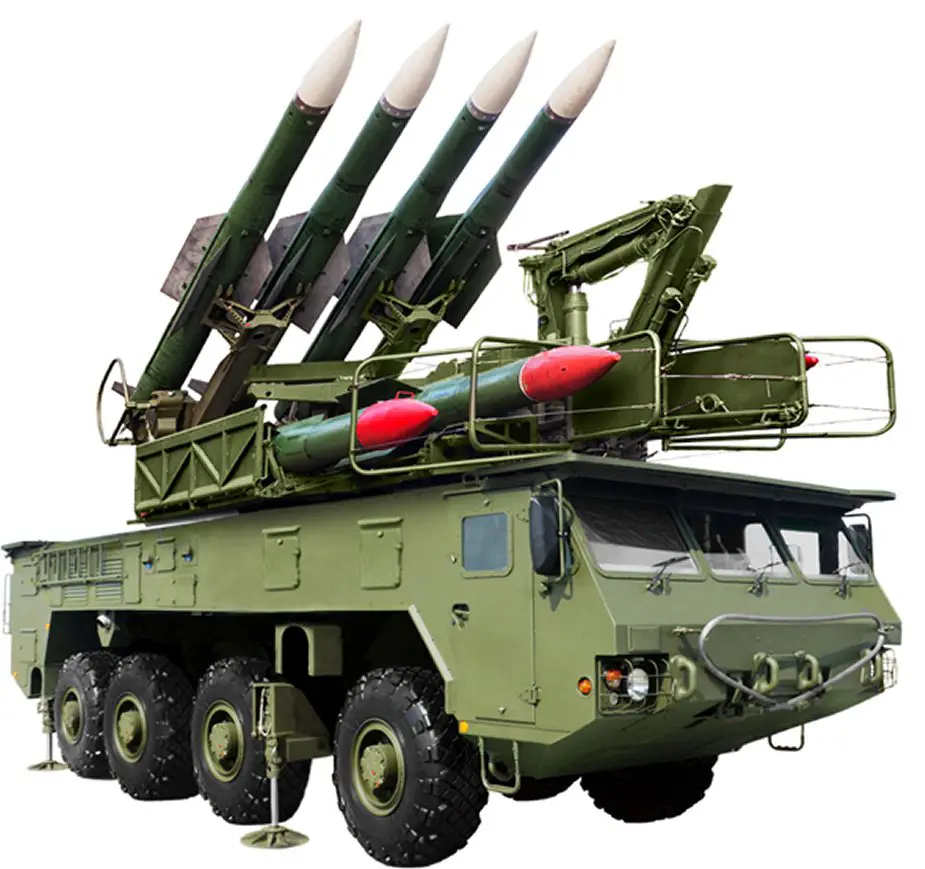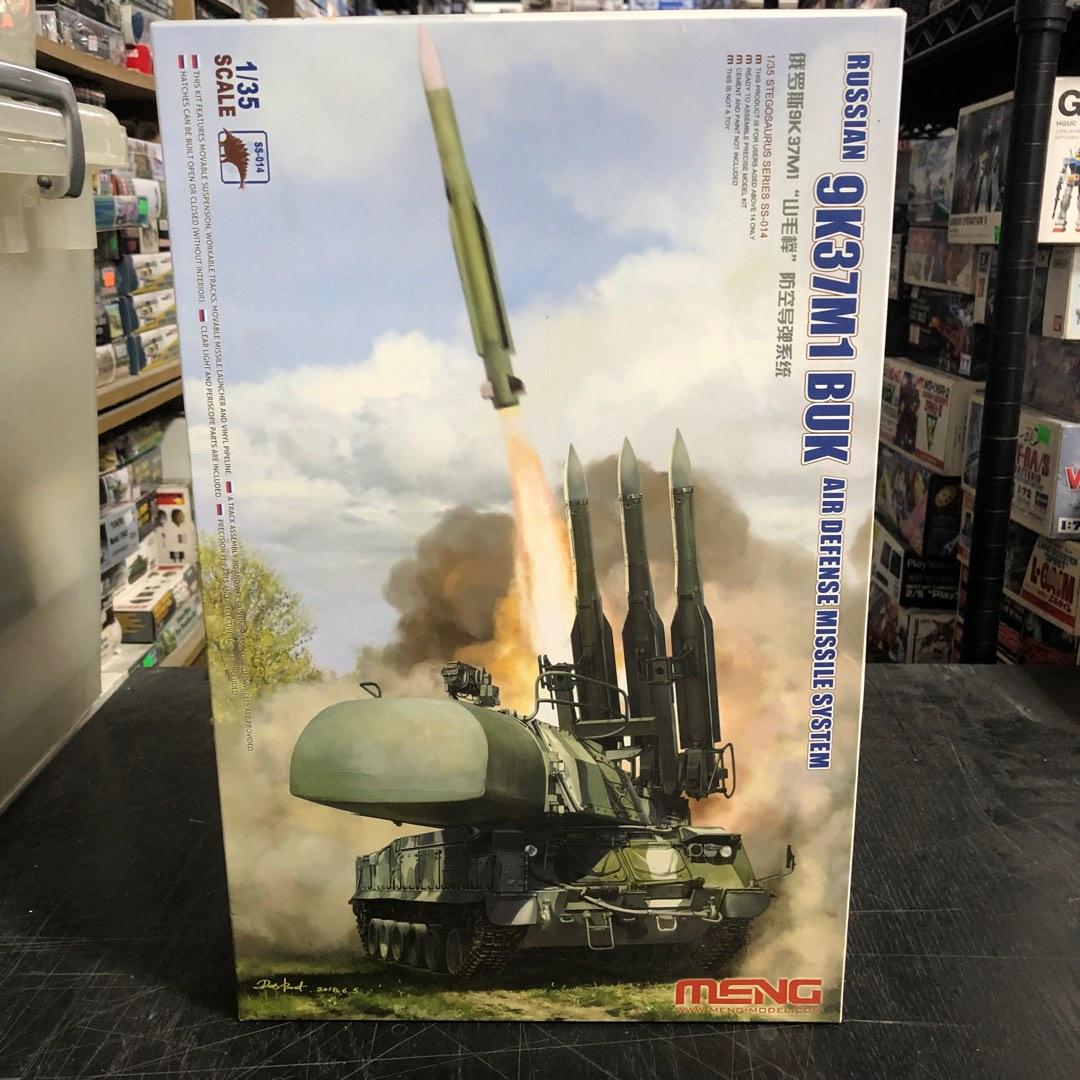Buk Air Defense - The Buk (Russian: "Бук"; "beech" (tree), /bʊk/) is a family of medium-range self-propelled surface-to-air missile systems developed by the Soviet Union and its successor state. the Russian Federation, and designed to counter cruise missiles, smart bombs, fixed and tri-wing aircraft, and unmanned aerial vehicles.
The first Buk version accepted into service was designated GRAU 9K37 Buk and was identified in the West by the NATO reporting name "Gadfly", as well as the US.
Buk Air Defense

With the integration of a new missile, the Buk-M1-2 and Buk-M2 systems also received a new NATO reporting name Grizzly and a new DOD designation SA-17. As of 2013, the latest incarnation "Buk-M3" is now in production and active service under a new DOD designation SA-27.
Russian Air Defense Weapons
A naval version of the system, designed by MNIIRE Altair (now part of GSKB Almaz-Antey) for the Russian Navy, has been given the designation GRAU 3S90M and will go by the NATO reporting name Gollum and a DOD designation SA-N-7C, according to Jane's Missiles & Rockets. The naval system was scheduled for delivery in 2014.
Development of the 9K37 "Buk" began on January 17, 1972 at the request of the Central Committee of the CPSU.
The development team included many of the same institutions that developed the earlier 2K12 "Cube" (NATO name "Gainful", SA-6), including the Tikhomirov Scientific Research Institute of Instrument Design (NIIP) as Lead Designer and Innovative Design . office, which was responsible for the development of missile armament.
In addition to the land system, a marine system was to be produced for the Navy: the 3S90 "Uragan" (Russian: "Ураган"; Hurricane) also bearing the designations SA-N-7 and "Gadfly".
Get Ready, America: Russia Will Soon Deploy An Air Defense System Better Than The S 300
The Buk missile system was designed to outperform the 2K12 Kub in all parameters, and its designers, including its chief designer Ardalion Rostov, visited Egypt in 1971 to see the Kub in action.
Both the Kub and the Buk used self-propelled launchers developed by Ardalion Rastov. As a result of the visit, the developers came to the conclusion that each Buk transporter erector launcher (TEL) should have its own fire control radar, instead of relying on a system-wide CTRAL radar as in KUB.
The result of the transition from TEL to Transporter Erector Launcher and Radar (TELAR) was a system capable of firing at multiple targets in multiple directions at the same time.

In 1974, developers determined that although the Buk missile system was the successor to the Kub missile system, both systems could share some interoperability. The result of this decision was the 9K37-1 Buk-1 system.
Buk Missile System Editorial Photography. Image Of Training
Interoperability between Buk TELAR and Kub TEL meant an increase in the number of fire control and missile channels available to each system, as well as faster testing of Buk system components in service. The Buk-1 was accepted into service in 1978 after completing state tests, while the complete Buk missile system was accepted into service in 1980.
The naval variant of the 9K37 "Buk", the 3S90 "Uragan", was developed by the Altair Design Bureau under the direction of chief designer G.N. Volgin.
The 3S90 used the same 9M38 missile as the 9K37, although the launcher and associated homing radars were swapped for naval variants. After the 9S90 system was tested between 1974 and 1976 on the Kashin Provorny-class destroyer, it was accepted into service in 1983 on the Project 956 Sovrmnyi-class destroyers.
As soon as the 9K37 "Buk" entered service, the Ctral Committee of the CPSU authorized the development of a modernized 9K37 that would become the 9K37M1 Buk-M1, accepted into service in 1983.
Belarus To Present New Medium Range Air Defense Missile System Buk Mb3k At Milex 2019
The modernization improved the performance of the system's radars, its "probability to kill" and its resistance to electronic countermeasures (ECM). In addition, a non-cooperative threat classification system was installed, based on the analysis of returned radar signals to clearly identify and distinguish civilian aircraft from potential military targets in the IFF abyss.
Another modification of the Buk missile system began in 1992 with work carried out between 1994 and 1997 to produce the 9K37M1-2 Buk-M1-2,
This modification introduced a new missile, the 9M317, which offered higher kinetic performance than the previous 9M38, which could still be used by the Buk-M1-2. Such sharing of the missile type led to a transition to a different GRAU designation, 9K317, which was used independently for all subsequent systems. The previous name of the 9K37 series was also preserved for the complex, as well as the name "Buk". The new missile, as well as a variety of other modifications, allows the system to shoot down ballistic missiles and surface targets, as well as increase the "gamete yield and speed" (danger zone for a possible attack) for more traditional targets such as aircraft and helicopters

The 9K37M1-2 Buk-M1-2 has also received a new NATO reporting name that distinguishes it from previous generations of the Buk system; The new report name was SA-17 Grizzly. The export version of the 9K37M1-2 system is called "Ural" (Russian: "Урал"); This name also applies to the M2, at least to the early towed export versions.
File:9a310 Self Propelled Launch Vehicle For Buk M1 2 Air Defence System.jpg
The introduction of the 9K37M1-2 system for the ground forces also marked the introduction of a new naval variant: the "Ezh", bearing the NATO reporting name SA-N-7B "Grizzly" (9M317 missile). It was exported under the name "Still" and has the NATO reporting name of SA-N-7C "Gollum" (missile 9M317E), according to Jane's catalog.
The 9K317 incorporates the 9M317 missile to replace the 9M38 used by the previous system. A further development of the system was presented as a concept at EURONAVAL 2004, a vertical launch variant of the 9M317, the 9M317ME, which is expected to be exported under the name "Shtil-1". Jane's also reported that in the Russian forces it would have a designation of 3S90M ("Smerch") (Russian: "Смерч", English translation: "Tornado").
The modernization of the Buk-M1-2: based on an earlier more advanced development system called the 9K317 "Buk-M2"
- Introduced new missiles and a new third-generation phased array fire control radar that allows targeting up to four targets while tracking 24 additional altitude aircraft.
Russia's New Buk M3 Air Defense Missile System Now Appears To Be In Ukraine (updated)
The grace of the Buk missile systems was stalled due to poor economic conditions after the fall of the Soviet Union. The system was presented as a static display at the 2007 MAKS Air Show.
In October 2007, Russian General Nikolai Frolov, commander of the air defense of the Russian ground forces, declared that the army would receive the brand new Buk-M3 to replace the Buk-M1. It stipulated that the M3 will have advanced electronic components and be in service in 2009.
A standard Buk battalion consists of one command vehicle, one target acquisition radar (TAR) vehicle, six launcher and radar (TELAR) vehicles, and three transport launcher (TEL) vehicles. A Buk missile battery consists of two TELAR vehicles and one TEL vehicle.

The TELAR superstructure is a turret with a fire control radar in the front and a launcher with four ready-to-fire missiles on top. Each TELAR is operated by a crew of four and equipped with chemical, biological, radiological and nuclear (CBRN) protection. It can carry up to three missiles against a single target. Although the first Buk has a 9Sh38 daytime radar tracking system (similar to those used in the KUB, TOR and OSA missile systems), its return design can be equipped with an optical tracking system combined with a thermal camera and a range finder laser for passives. Goal tracking. The 9K37 system can also use the same 25kW G/H band continuous wave radar with 1S91 direct flash as the 3M9 "Cube" system.
False: This Is Not Russia's Buk M3 Viking Air Defence System In Ukraine In 2022
The original Buk TELAR's 9S35 radar uses a mechanical scan of a Cassegrain antenna reflector, where the Buk-M2 TELAR design used a PESA, for missile tracking and guidance.
The 9K37 uses the 9S18 "Pipe Arm" or 9S18M1 (NATO reporting name "Snow Drift") target acquisition radar (Russian: СОЦ 9C18 "Купол"; Kupol) in combination with the 9S35 band tracking or 9S35M I. and Gagamet radar that is mounted on each LOOM. The Snow Drift Target Acquisition Radar has a maximum detection range of 85 km (53 mi) and can detect an aircraft flying 100 m (330 ft) from 35 km (22 mi) away and flying targets more high at a distance of between 10 and 20 miles. km (6-12 miles).
The TEL reloading vehicle for the Buk battery resembles the TELAR, but instead of a radar they have a crane for loading missiles. They are capable of launching missiles directly, but require the cooperation of a TELAR-equipped fire dome for missile guidance. A Reload Vehicle can transfer its missiles to a LOOM in about 13 minutes and can reload them from stores in about 15 minutes.
In addition, the Buk-M2 has a new vehicle like TELAR but with radar above a telescopic elevator and no missiles, called the 9S36 Target Acquisition Radar (TAR). The vehicle can be used together with two TEL 9A316 to attack up to four targets, guide with missiles in forests or mountainous regions.
Buk M1 2 \
The Buk-M2E mobile SAM simulator was shown at MAKS-2013. A mobile-based JMA 9A317ET SAM "Buk-M2E" self-propelled fire simulator installation is designed to train and evaluate the
Air defense radar, air max algae defense, self defense air horn, air base defense, air defense system, buk surface to air missile system, buk air defence, air defense, air-defense, patriot air defense system, self defense air gun, air defense artillery
0 Comments